INSTITUT SUPERIEUR D'ANTHROPOLOGIE
INSTITUTE OF ANTHROPOLOGY
ONLINE COURSES / COURS A DISTANCE
FALL TERM : OCTOBER 2015
REGISTER NOW
ROYAUME UNI –  Lesnes - Ancient artefacts have been discovered in Lesnes Abbey Woods Park during work to improve the area. The pieces were unearthed close to the foundations of the old 1930s amenity building in the park. Some of the artefacts found - which include human remains - are currently being examined offsite by specialist professional teams.
Lesnes - Ancient artefacts have been discovered in Lesnes Abbey Woods Park during work to improve the area. The pieces were unearthed close to the foundations of the old 1930s amenity building in the park. Some of the artefacts found - which include human remains - are currently being examined offsite by specialist professional teams.
http://www.bexleytimes.co.uk/news/archaeological_artefacts_unearthed_at_lesnes_abbey_woods_park_1_4206138
LIBAN – Dimane - Des ossements humains et des morceaux de poterie ont été découverts jeudi au siège patriarcal de Dimane, au Liban-Nord par des membres de l'Association culturelle et spirituelle de Qannoubine qui travaillaient sur le site, rapporte l'Agence nationale d'information (Ani, officielle). Selon les premières constatations, les ossements retrouvés seraient des doigts appartenant à une même main, précise l'Ani. Ces éléments archéologiques ont été découverts dans plusieurs caves datant de l'époque du patriarche Youhanna el-Hélou, au début du XIXème siècle, ajoute l'agence. La Direction générale des antiquités va se rendre sur les lieux de la découverte.
http://www.lorientlejour.com/article/940089/decouverte-archeologique-au-siege-patriarcal-de-dimane.html
FRANCE – 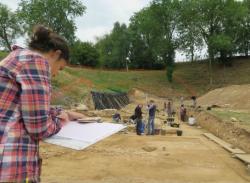 Genainville - Du plus grand site gallo-romain d’Ile-de-France, on ne connaît encore que peu de chose… Chaque été, l’équipe d’archéologue de l’AEVA (l’Association Étudiante Valdoisienne d’Archéologie) lève pourtant un petit coin du voile sur Genainville. Et la saison de fouilles 2015 s’annonce prometteuse. Car étudiants et bénévoles se consacrent, depuis la fin juillet et jusqu’au 27 août, à une partie très peu connue du sanctuaire antique. Découvert en 1935, l’ensemble gallo-romain de Genainville a fait l’objet de fouilles essentiellement entre 1960 et 1991, sous la direction du chercheur Pierre-Henri Mitard. Des années, et moult péripéties plus tard, le site une fois sauvé a de nouveau été étudié à partir de 2004 par l’AEVA. « Durant les dix dernières années, les recherches se sont concentrées sur l’aire sacrée », explique Vivien Barrière, le responsable des opérations. Enterrés pendant des siècles sous le vallon, les murs de ce temple du IIe siècle (probablement consacré au dieu romain Mercure et à la déesse gauloise Rosemerta) atteignent encore aujourd’hui 4 à 5 m de haute. Un vestige rarissime en France !Mais là n’est pas la seule richesse du site dit du Vaux-de-la-Celle. « Pierre-Henri Mitard a un peu fouillé le théâtre, mais n’a quasi rien publié. Cela méritait que l’on retourne y voir », détaille Vivien. Les archéologues ont créé une « aire ouverte » de fouilles de 500 m2 pour tenter de « rassembler toutes les pièces du puzzle ». On perçoit encore aujourd’hui, sur le site envahi de nature, les proportions gigantesques de cet édifice de spectacle qui pouvait accueillir un minimum de 4 000 spectateurs, ou « peut-être le double ». Les chercheurs vont maintenant imaginer la vie des Gaulois des premiers siècles de notre ère. « L’enjeu, c’est de comprendre comment fonctionnait le théâtre, par où les spectateurs entraient et sortaient, comment on pénétrait dans l’arène… », explique Vivien Barrière. Et ce n’est qu’un début. « Dans les années à venir, l’espace entre le théâtre et l’aire sacrée nous intéressera. Le site de Genainville est vraiment important pour les archéologues travaillant sur la Gaule romaine. Il n’est pas encore très connu, mais le deviendra. » Et l’aménagement imminent d’un véritable centre de recherches sur place devrait accélérer ce destin.
Genainville - Du plus grand site gallo-romain d’Ile-de-France, on ne connaît encore que peu de chose… Chaque été, l’équipe d’archéologue de l’AEVA (l’Association Étudiante Valdoisienne d’Archéologie) lève pourtant un petit coin du voile sur Genainville. Et la saison de fouilles 2015 s’annonce prometteuse. Car étudiants et bénévoles se consacrent, depuis la fin juillet et jusqu’au 27 août, à une partie très peu connue du sanctuaire antique. Découvert en 1935, l’ensemble gallo-romain de Genainville a fait l’objet de fouilles essentiellement entre 1960 et 1991, sous la direction du chercheur Pierre-Henri Mitard. Des années, et moult péripéties plus tard, le site une fois sauvé a de nouveau été étudié à partir de 2004 par l’AEVA. « Durant les dix dernières années, les recherches se sont concentrées sur l’aire sacrée », explique Vivien Barrière, le responsable des opérations. Enterrés pendant des siècles sous le vallon, les murs de ce temple du IIe siècle (probablement consacré au dieu romain Mercure et à la déesse gauloise Rosemerta) atteignent encore aujourd’hui 4 à 5 m de haute. Un vestige rarissime en France !Mais là n’est pas la seule richesse du site dit du Vaux-de-la-Celle. « Pierre-Henri Mitard a un peu fouillé le théâtre, mais n’a quasi rien publié. Cela méritait que l’on retourne y voir », détaille Vivien. Les archéologues ont créé une « aire ouverte » de fouilles de 500 m2 pour tenter de « rassembler toutes les pièces du puzzle ». On perçoit encore aujourd’hui, sur le site envahi de nature, les proportions gigantesques de cet édifice de spectacle qui pouvait accueillir un minimum de 4 000 spectateurs, ou « peut-être le double ». Les chercheurs vont maintenant imaginer la vie des Gaulois des premiers siècles de notre ère. « L’enjeu, c’est de comprendre comment fonctionnait le théâtre, par où les spectateurs entraient et sortaient, comment on pénétrait dans l’arène… », explique Vivien Barrière. Et ce n’est qu’un début. « Dans les années à venir, l’espace entre le théâtre et l’aire sacrée nous intéressera. Le site de Genainville est vraiment important pour les archéologues travaillant sur la Gaule romaine. Il n’est pas encore très connu, mais le deviendra. » Et l’aménagement imminent d’un véritable centre de recherches sur place devrait accélérer ce destin.
http://www.leparisien.fr/genainville-95420/des-passionnes-d-archeologie-fouillent-le-sanctuaire-antique-de-genainville-20-08-2015-5023279.php
SYRIE – 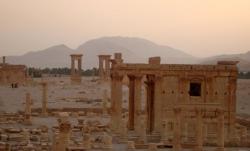 Palmyre - Islamic State's demolition of an renowned ancient Roman temple in the Syrian city of Palmyra is a war crime that targeted an historic symbol of the country's diversity, the U.N. cultural agency UNESCO said on Monday. Ultra hardline Islamic State militants blew up the temple of Baal Shamin on Sunday, Syria's antiquities chief Maamoun Abdulkarim said, describing the destruction of one of the most important sites in the central city. "Such acts are war crimes and their perpetrators must be accountable for their actions," UNESCO Director General Irina Bokova said in a statement. She also condemned the killing of Khaled al-Asaad, an 82-year-old archaeologist who had looked after Palmyra's UNESCO World Heritage ruins for four decades. Abdulkarim said last week Islamic State had beheaded Asaad and hung his body from one of Palmyra's Roman-era columns. Before the capture of Palmyra by Islamic State, Syrian officials said they moved hundreds of ancient statues to safe locations out of concern the militants would destroy them.
Palmyre - Islamic State's demolition of an renowned ancient Roman temple in the Syrian city of Palmyra is a war crime that targeted an historic symbol of the country's diversity, the U.N. cultural agency UNESCO said on Monday. Ultra hardline Islamic State militants blew up the temple of Baal Shamin on Sunday, Syria's antiquities chief Maamoun Abdulkarim said, describing the destruction of one of the most important sites in the central city. "Such acts are war crimes and their perpetrators must be accountable for their actions," UNESCO Director General Irina Bokova said in a statement. She also condemned the killing of Khaled al-Asaad, an 82-year-old archaeologist who had looked after Palmyra's UNESCO World Heritage ruins for four decades. Abdulkarim said last week Islamic State had beheaded Asaad and hung his body from one of Palmyra's Roman-era columns. Before the capture of Palmyra by Islamic State, Syrian officials said they moved hundreds of ancient statues to safe locations out of concern the militants would destroy them.
http://uk.reuters.com/article/2015/08/24/uk-mideast-crisis-syria-palmyra-idUKKCN0QT1NR20150824?rpc=401
DANEMARK – 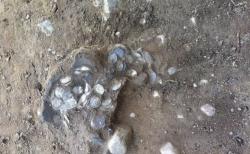 Errested - Amateur archaeologists have made a sensational find of Viking Age silver coins in a field in Errested near Haderslev in south Jutland. So far, a total of 165 coins, dating back to the beginning of the 11th century, have been found, but they have not yet excavated the source of the treasure: a vase filed with coins, according to Anders Hartvig, a spokesperson for Arkæologi Haderslev. “It’s quite sensational. It’s the first time in south Jutland that we have found such a huge find from the beginning of the 1000s,” Hartvig told Ekstra Bladet tabloid. “There are English, Danish and German coins and the faces on some of them are still very visible. For instance, Knud den Store [Cnut the Great], the king who ruled Denmark and England, minted some of the coins.” According to Hartvig, the treasure also includes a golden pearl that was probably part of a pearl necklace. The treasure was actually discovered in the field last year, but the archaeologists had to wait until the field was harvested before making a more extensive dig.
Errested - Amateur archaeologists have made a sensational find of Viking Age silver coins in a field in Errested near Haderslev in south Jutland. So far, a total of 165 coins, dating back to the beginning of the 11th century, have been found, but they have not yet excavated the source of the treasure: a vase filed with coins, according to Anders Hartvig, a spokesperson for Arkæologi Haderslev. “It’s quite sensational. It’s the first time in south Jutland that we have found such a huge find from the beginning of the 1000s,” Hartvig told Ekstra Bladet tabloid. “There are English, Danish and German coins and the faces on some of them are still very visible. For instance, Knud den Store [Cnut the Great], the king who ruled Denmark and England, minted some of the coins.” According to Hartvig, the treasure also includes a golden pearl that was probably part of a pearl necklace. The treasure was actually discovered in the field last year, but the archaeologists had to wait until the field was harvested before making a more extensive dig.
http://cphpost.dk/news/amateur-archaeologists-make-sensational-find-in-jutland-field.html?
USA – 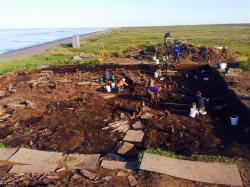 Quinhagak - At a site near the Southwest Alaska village of Quinhagak archeologists are racing against time to uncover Yup’ik artifacts before the effects of climate change cause them to erode into the sea. The old village continues to reveal artifacts that give a glimpse into the daily lives of Yup’ik people hundreds of years ago. The crowning artifact found this season, says Rick Knecht, the lead archeologist and a professor from the University of Aberdeen in Scotland, is a mask — half human, half walrus — in nearly perfect condition. It’s wrapped in several layers of plastic as Knecht keeps the mask damp and cool in a refrigerator at base camp. “It’s got amazingly lifelike contours with the cheek bones, and the nose, and the forehead and so on. Beautifully carved out of wood, and as you can see it’s got two little conical tusks that represent that transformation into a walrus. And these are in fact made out of walrus ivory. It’s got a little beard here, and half of it are human hairs and then on the other half are sea mammal hairs, maybe walrus whiskers,” said Knecht. Knecht says the mask could have been a used by a Shaman. He unearthed it, about five miles outside Quinhagak, on the edge of the Bering Sea, where archeologists have spent the six field seasons scraping dirt from the remains of a 500-year old Alaska Native sod house. Today’s discovery of a wooden bowl gives another clue about how Yup’ik people lived.
Quinhagak - At a site near the Southwest Alaska village of Quinhagak archeologists are racing against time to uncover Yup’ik artifacts before the effects of climate change cause them to erode into the sea. The old village continues to reveal artifacts that give a glimpse into the daily lives of Yup’ik people hundreds of years ago. The crowning artifact found this season, says Rick Knecht, the lead archeologist and a professor from the University of Aberdeen in Scotland, is a mask — half human, half walrus — in nearly perfect condition. It’s wrapped in several layers of plastic as Knecht keeps the mask damp and cool in a refrigerator at base camp. “It’s got amazingly lifelike contours with the cheek bones, and the nose, and the forehead and so on. Beautifully carved out of wood, and as you can see it’s got two little conical tusks that represent that transformation into a walrus. And these are in fact made out of walrus ivory. It’s got a little beard here, and half of it are human hairs and then on the other half are sea mammal hairs, maybe walrus whiskers,” said Knecht. Knecht says the mask could have been a used by a Shaman. He unearthed it, about five miles outside Quinhagak, on the edge of the Bering Sea, where archeologists have spent the six field seasons scraping dirt from the remains of a 500-year old Alaska Native sod house. Today’s discovery of a wooden bowl gives another clue about how Yup’ik people lived.
http://www.alaskapublic.org/2015/08/21/archaeologists-uncover-new-yupik-artifacts-near-quinhagak/
TURQUIE – 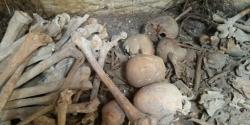 Yağış - Sixty bodies were found on Sunday in a mass grave dating back to Roman times in a field in the Central Anatolian province of Kütahya by a farmer plowing the field with a mule. The remnants, which were discovered near the village of Yağış in the Emet district of Kütahya, are thought to belong to people aged between 10 and 60 and to date back to Roman times. Officials who came to the area to oversee the investigation told reporters that the site was located in difficult terrain and that the exhumation team had been forced to remove the bodies by hand due to the location. The bones have reportedly been transported to Kütahya University's archeology department along with soil samples, and the final results of the investigation will reportedly be released in the upcoming days. The mass grave is located on an ancient line of defense works and underground storage rooms dating back to Roman times.
Yağış - Sixty bodies were found on Sunday in a mass grave dating back to Roman times in a field in the Central Anatolian province of Kütahya by a farmer plowing the field with a mule. The remnants, which were discovered near the village of Yağış in the Emet district of Kütahya, are thought to belong to people aged between 10 and 60 and to date back to Roman times. Officials who came to the area to oversee the investigation told reporters that the site was located in difficult terrain and that the exhumation team had been forced to remove the bodies by hand due to the location. The bones have reportedly been transported to Kütahya University's archeology department along with soil samples, and the final results of the investigation will reportedly be released in the upcoming days. The mass grave is located on an ancient line of defense works and underground storage rooms dating back to Roman times.
http://www.todayszaman.com/national_roman-era-mass-grave-with-60-bodies-found-in-kutahya_397346.html?
BULGARIE – 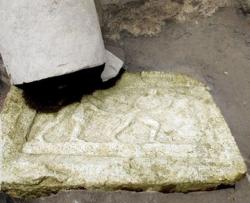 Augusta Traiana - A marble slab from the frieze of an ancient temple in the Roman city of Augusta Traiana depicting two fighting gladiators as been discovered together with herms and an inscription mentioningRoman Caesars during rescue archaeological excavations in the southern Bulgarian city of Stara Zagora. The marble slab which is 115 cm long and 83 cm wide has been discovered by archaeologist Maria Kamisheva . The slab is decorated with the clearly visible depictions of two gladiators – one of them attacking with a sword and a shield, and another who seems to be retreating, holding a spear and a trident. The gladiator slab was most probably part of the frieze – the central part of an entablature of ancient buildings often decorated with reliefs – of a Roman temple in the city of Augusta Traiana. The archaeologists carrying out the rescue excavations have also found two herms – sculptures withhuman heads above a plain lower section. The herms come from the same Roman temple. Both are decorated with male heads wearing what appear to be gladiator helmets. Another exciting discovery is a donor’s inscription stating the exact year when the Augusta Traiana temple was built – 303 AD. The inscription says the temple was erected by the governor of the Roman province of Thrace, Emilius Alexander, “for the glory of Roman Caesars Galerius Valerius Maximianus and Flavius Valerius Constantius” (i.e. Galerius and Constantius Chlorus).
Augusta Traiana - A marble slab from the frieze of an ancient temple in the Roman city of Augusta Traiana depicting two fighting gladiators as been discovered together with herms and an inscription mentioningRoman Caesars during rescue archaeological excavations in the southern Bulgarian city of Stara Zagora. The marble slab which is 115 cm long and 83 cm wide has been discovered by archaeologist Maria Kamisheva . The slab is decorated with the clearly visible depictions of two gladiators – one of them attacking with a sword and a shield, and another who seems to be retreating, holding a spear and a trident. The gladiator slab was most probably part of the frieze – the central part of an entablature of ancient buildings often decorated with reliefs – of a Roman temple in the city of Augusta Traiana. The archaeologists carrying out the rescue excavations have also found two herms – sculptures withhuman heads above a plain lower section. The herms come from the same Roman temple. Both are decorated with male heads wearing what appear to be gladiator helmets. Another exciting discovery is a donor’s inscription stating the exact year when the Augusta Traiana temple was built – 303 AD. The inscription says the temple was erected by the governor of the Roman province of Thrace, Emilius Alexander, “for the glory of Roman Caesars Galerius Valerius Maximianus and Flavius Valerius Constantius” (i.e. Galerius and Constantius Chlorus).
http://archaeologyinbulgaria.com/2015/08/21/archaeologist-finds-gladiator-relief-inscription-mentioning-roman-caesars-in-ancient-city-augusta-traiana-in-bulgarias-stara-zagora/